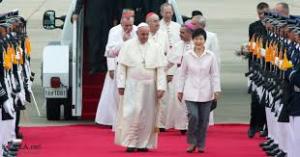Pope Francis’ Prescription for South Korea
 Amidst a summer filled with depressing news around the world, South Korea was fortunate enough to host a five-day visit from Pope Francis from August 14 - 18. While the primary purposes of his visit were to celebrate Asia Youth Day and to beatify Korean martyrs, the Pope also sought to provide consolation and enlightenment to both Christians and non-Christians in the country.
Amidst a summer filled with depressing news around the world, South Korea was fortunate enough to host a five-day visit from Pope Francis from August 14 - 18. While the primary purposes of his visit were to celebrate Asia Youth Day and to beatify Korean martyrs, the Pope also sought to provide consolation and enlightenment to both Christians and non-Christians in the country.
Indeed, Pope Francis had a busy itinerary, addressing thousands of young people from different parts of Asia, beatifying 125 martyrs sacrificed in the 18th and the 19th century during the royal persecution of Christians, as well as visiting a small village called Kottongnae (Flower Village in Korean), where most of the residents are elderly citizens living alone and physically or mentally disabled.
Pope Francis’ visit to South Korea was especially remarkable, considering that Asia had not had a Pope’s visit for the last 20 years. Despite being a region of dynamic change, including the growing economy, outbreaks of violence and rapidly growing Catholicism, Pope John Paul II’s visit to the Philippines in 1995 marked the last Papal visit to the continent. After a two-decade gap in engagement with the continent, a visit to Asia was undoubtedly an important task for Pope Francis since his inauguration. The Pope’s visit also signifies the Holy See’s recognition of the exponential growth of Catholicism in South Korea. Catholic population in the country has grown about 70 percent in the last decade, reaching 10.4% of the entire population as of 2013. This year, South Korea hosted the 6th Asia Youth Day, a grand meeting of Catholic youths from all over Asia, aimed at promoting communication and strengthening beliefs. Addressing about 6000 youths, Pope Francis emphasized the need for respecting diversity in the continent and the importance of showing love for people in need of help.
During his visit, Pope Francis impressed the country with his remarkable level of understanding of Korean society and his sincerity. The Pope frequently got out of his vehicle (a compact car produced by a Korean company, Kia), to meet the public by himself. His visit to Kottongnae lasted longer than originally planned, because he met and hugged all residents of the village. When giving a speech in Daejeon, the Pope addressed the public in English for the first time in an effort to communicate with young people, even making frank comments about his own lack of fluency. As for the Mass held on the last day of his visit in Seoul, the Pope invited the “comfort women,” formerly victimized as military sex slaves during the Japanese Occupation, and laid-off workers of Ssangyong Motor Company, whose strikes and protests have stoked a political controversy in Korea.
The most notable—and perhaps controversial—aspect of his visit was his special attention given to parents of the Sewol ferry accident. On April 16 this year, the Sewol ferry sank en route from Incheon to Jeju, causing the deaths of almost 300 passengers who were mostly high school students. The accident exposed the long-standing corruption and collusion between the government and sailing industries, which eventually led to mismanagement of ships and violation of sailing rules. During his visit, Pope Francis had a private meeting with the families of the victims and survivors of the accident. A small yellow ribbon, widely used in South Korea to pray for the missing victims to come back and to mourn for the dead, was constantly fixed on his chest during the five days. The Pope also promised to bring to Rome the cross used by the families during their march, and baptized a father of a victim, granting him the name Francis.
Unfortunately, Pope Francis’ especial attention to the victims have taken on political undertones. In the last few months, the ruling Saenuri Party governing and the opposition Democratic Party party have been starkly divided over the issue of reparations for victims and establishment of an independent commission of inquiry probe. As the confrontation between the two parties escalated, the Sewol ferry accident has gradually turned into a subject of political dispute. Even after Pope Francis returned to the Vatican, the deadlock between the opposition party supported by the families of victims, and the governing party still has not seen any progress. Though aware of the possible political implications of his actions, the Pope has said that he “could not stay neutral before the pain of the bereaved families”, and did not hesitate to get off the car to personally express his sympathy to the families of the victims.
Pope Francis’ overall message was in line with his mission to care for a country’s most marginalized people. The people whom Pope Francis was most concerned about were not those at the center of a political dispute, but were the most forgotten people in South Korean society; those who suffer the most usually happen to be at the center of political controversy precisely because they expose deep-rooted societal problems. The Pope’s connections with the people seem to have their roots in his wish for South Korea as expressed during the Mass in Seoul, which was peace and reconciliation. Pope Francis not only realized the meaning of sincere concern and consolation, but also called upon South Korea to review its unresolved wounds and hostilities. The influence of his five-day visit has thus far generated a temporary wave of self-reflection. In order for South Korea to move towards national reconciliation, the country must carefully consider the message he left behind.
